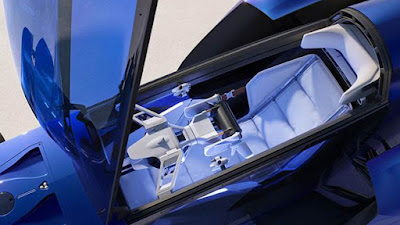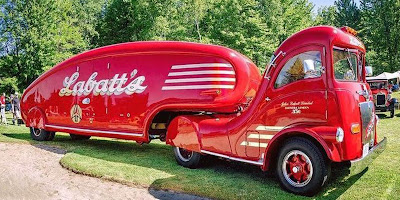Unique Creation - In the world of automotive history, there are certain vehicles that stand out due to their distinctiveness, often resulting from collaborations that merge different industries. One such unique creation came from the merging of Italian motorcycle expertise and automotive innovation. It was the collaboration between
Cagiva, an iconic Italian motorcycle manufacturer, and
Lomar, a small but ambitious car company, that birthed the remarkable three-wheeled car known as
Honey. This unusual vehicle, which used a motorcycle engine and was targeted at a niche market, quickly gained attention for its innovative design and functionality, although it would not see widespread production. Despite its short-lived commercial existence, the Honey has since become an intriguing piece of automotive history.
 |
The Lomar Honey was presented by Giampiero Lombatti (left) to a visitor at the stand during the 1985 Salone del Ciclo e Motociclo di Milan (Milan Motorcycle Show). (Picture from: AutoTecnica)
|
The story behind the creation of the
Honey car begins with
the two founders of Lomar,
Giampiero Lombatti and
Fulvio Martini,
both from Parma, Italy.
The name "Lomar" is actually an acronym derived from their surnames.
Lombatti hailed from a family with a strong connection to the automotive world, specifically
Fiat’s historic dealerships. On the other hand,
Martini came from
the Coenzo family, known for their involvement with expanded resins. Their diverse backgrounds would contribute to the creation of a lightweight car that was quite ahead of its time. Their collaboration was made even more interesting by the support they received from
Cagiva, a well-known name in the world of motorcycles.
 |
| The Lomar Honey was equipped with two gull-wing doors that could be easily removed during the summer months, transforming the car from a coupé to a convertible. (Picture from: AutoTecnica) |
The design of
the first Honey prototype was overseen by
Walter Cugini, a skilled designer with experience in the automotive world. The chassis was developed by a studio already working with renowned car manufacturers in Modena, a city famous for its automotive legacy. Initially,
the bodywork was crafted using steel sheet metal,
meticulously hand-stroked by Gianni Gobbi,
an experienced bodyworker from Italcar. However, as the project progressed,
the design switched to fiberglass and polyester resin, a decision that allowed for significant weight reduction, making the vehicle more agile and efficient.
 |
| The Lomar Honey, approved as a motor-carriage, was powered by a 20-horsepower, liquid-cooled Cagiva 125 motorcycle engine and required an A-carriage license to drive. (Picture from: AutoTecnica) |
The car’s debut at
the 1985 Salone del Ciclo e Motociclo di Milan (Milan Motorcycle Show) caught the attention of many visitors and industry professionals. It was instantly recognized for its innovative use of
a small three-wheeled layout,
powered by a single-cylinder 125cc engine from Cagiva.
This engine, a two-stroke design, was already popular in
Cagiva’s motorcycles, particularly
the Aletta Rossa 125 model.
With a maximum power output of around 20 horsepower, the engine was capable of propelling the
Honey to
a top speed of 90 kilometers per hour, which was impressive for a vehicle of its size and design.
 |
| The Cagiva Aletta Rossa, shared the single-cylinder two-stroke 125cc engine and the modified gearbox with the Lomar Honey. (Picture from: DannataVintage) |
One of the most eye-catching features of the
Honey was
its streamlined, modern coupé design.
The body of the vehicle was compact,
measuring just 3.6 meters in length and 1.6 meters in width.
Its low height of 1.25 meters gave it a sleek profile. The
Honey was equipped with
two gull-wing doors that could be easily removed during the summer months, transforming the car from a coupé to a convertible. This unique feature added to the vehicle's appeal, as it combined the practicality of a small car with the fun of an open-air driving experience. The vehicle’s frame was made of steel tubes, ensuring strength and durability,
while the use of fiberglass for the body panels kept the overall weight to just 300 kilograms.
 |
| The Lomar Honey featured a well-appointed interior with a sports steering wheel, and a dashboard with complete instrumentation. (Picture from: AutoTecnica) |
The
Honey was designed with comfort in mind, offering a well-appointed cockpit for its passengers. Inside, the car featured
two comfortable armchairs,
a sports steering wheel,
and a dashboard with complete instrumentation, similar to what you might find in more mainstream vehicles like
the Fiat Ritmo.
The gear lever was located on the central tunnel, making the driving experience more intuitive. The car's design was clearly intended to appeal to
a younger audience, particularly those aged 16 and above,
who would only need an "A" license in Italy to drive it.
 |
| The Lomar Honey featured a well-finished, elegant interior with two seats designed in a sporty and ergonomic shape, enhancing both style and comfort. (Picture from: AutoTecnica) |
However, despite the initial enthusiasm and interest from both the public and the industry, the Honey faced significant challenges when it came to production. The costs of industrializing the car proved to be far too high for
Lomar and its small-scale operations. The two founders, unable to secure the necessary capital, had no choice but to abandon their dream of becoming car manufacturers. The Honey, which had been created with so much promise, remained
a one-of-a-kind prototype and has since become a rare collector's item.
 |
| The Lomar Honey's bodywork was initially crafted from steel sheets by Gianni Gobbi, but during the start of series production, it transitioned to fiberglass and polyester resin. (Picture from: AutoTecnica) |
Although the
Honey was not destined for mass production, it remains an intriguing part of automotive history. The combination of
Cagiva’s motorcycle engineering and
Lomar’s car design was a bold attempt to break the mold and offer a unique solution to the challenges of urban mobility. Today, the
Honey is still carefully preserved, a testament to the vision of its creators and the potential that could have been. The vehicle represents an early example of a light, compact car that could have paved the way for future innovations in small-scale transportation.
 |
| The Lomar Honey featured a compact body measuring 3.6 meters in length, 1.6 meters in width, and a low height of 1.25 meters, giving it a sleek profile. (Picture from: AutoTecnica) |

The story of the
Honey serves as a reminder of the often unpredictable nature of automotive innovation. While the car did not achieve commercial success, its design and engineering principles have influenced later developments in the field of small vehicles and microcars. The
Honey's legacy lives on in the form of its unique engineering, the ingenuity of its creators, and the fascination it continues to inspire in automotive enthusiasts. It is a shining example of how bold ideas, even when faced with insurmountable obstacles, can leave a lasting impression on the world.
*** [EKA | FROM VARIOUS SOURCES | DANNATAVINTAGE | AUTOTECNICA | ALLCARINDEX | WIKIPEDIA ]Note: This blog can be accessed via your smart phone.





 For all its promise, Eagle Cars Limited left behind a legacy defined by ambition and innovation. The Eagle SS, with its dramatic design and versatile configurations, remains a symbol of an era when small manufacturers dared to dream big. While only a fraction of the 680+ units produced remain, their enduring appeal serves as a testament to a company that dared to think differently. *** [EKA | FROM VARIOUS SOURCES | EAGLEOWNERCLUB | RARECOMPONENTCARS | WIKIPEDIA | CARTEFACTS | AUTA5P.EU | NVAUTOMOTIVE ]
For all its promise, Eagle Cars Limited left behind a legacy defined by ambition and innovation. The Eagle SS, with its dramatic design and versatile configurations, remains a symbol of an era when small manufacturers dared to dream big. While only a fraction of the 680+ units produced remain, their enduring appeal serves as a testament to a company that dared to think differently. *** [EKA | FROM VARIOUS SOURCES | EAGLEOWNERCLUB | RARECOMPONENTCARS | WIKIPEDIA | CARTEFACTS | AUTA5P.EU | NVAUTOMOTIVE ]

































